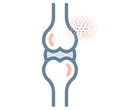Osteopetrosis
Osteopetrosis, also known as “marble bone disease”, is a term referred to a group of skeletal disease that are characterized by a generalized increase in bone density due to a defective bone resorption by osteoclasts, the cells in charge of this function in bone tissue.





